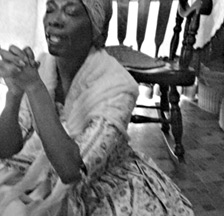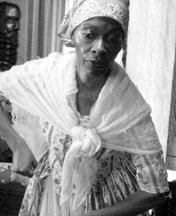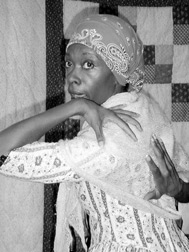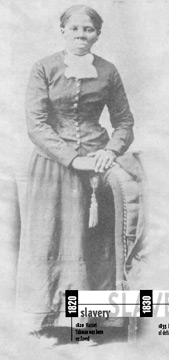|
|
 Being Harriet Tubman Being Harriet Tubman
I was drawn into Harriet Tubman’s story because it inspired me.
I became her to inspire others.
by Deborah L. Wright
Harriet Tubman, born and reared enslaved on a Maryland Eastern Shore plantation, fled bondage and became a noted conductor on the Underground Railroad, according to historical accounts. She is credited with leading more than 200 people to freedom.
Much has been written about the journeys she made, eluding slave traders, overcoming hunger and stretching the limits her body would endure. One account describes her arrival in freedom land, along with six runaway slaves.
“Harriet and one of the men had worn their shoes off their feet and I gave them two dollars to help fit them out and directed a carriage to be hired at my expense, to take them out, but do not yet know the expense,” wrote Thomas Garrett who witnessed the arrival of the conductor and her followers.
The letter is dated December 29, 1854. That was roughly five years after most historians believe the Dorchester County field hand made her initial dash for freedom. That account, entitled “Moses Arrives With Six Passengers,” was apparently written after Tubman had already made several trips back to Maryland.
“Harriet had been their Moses,” Garrett wrote from Wilmington, Delaware. “She had faithfully gone down into Egypt and had delivered these six bondmen by her own heroism.”
Slavery on our Shore
Growing up in Chicago, I had not read much about Harriet Tubman’s travels. When I moved to Baltimore in 1981 to accept a position as a television news reporter, I was drawn into her story because it inspired me.
I wondered how a five-foot-tall, enslaved field hand could develop the wherewithal not only to escape the confines of involuntary servitude but also to orchestrate the escape of many others.
After all, Tubman’s experience affirmed one certainty: lifelong bondage.
Harriet Tubman was born into slavery around 1820. It’s difficult to pinpoint her exact birth date because such records were not kept for slaves.
She was born on the plantation of Edward Brodas, though some historians list the name as Brodess. Bucktown was the closest town to the Brodas plantation. Baltimore was roughly 60 miles away. Edward Brodas was said to have been a humane master by the standards of his day. Even so, money problems reportedly forced him to hire out some slaves and to sell others.
Tubman’s parents, Harriet Greene and Ben Ross, were reportedly married. Often marriages between slaves amounted to little more than pairings off by the master of males and females who were most likely to produce healthy offspring. Her family was supposedly a close one, with most siblings living on or near the same plantation. Still, family members experienced the pain of separation when at least two of Harriet’s siblings were sold to Southern chain gangs.
As a child, Tubman was called Araminta, Minty or Minta. Such “basket names” were used for slave children until their behavior was deemed mature enough for them to be considered adults. Even as a youngster, Minty reportedly had a free spirit.
At age six, she supposedly ran away from an abusive mistress who had hired the child and threatened to beat her for taking a lump of sugar.
 |
| Not only was Tubman a slave; she was also damaged merchandise. Books describe how she was hit in the head with a two-pound weight when she used her body as a human shield between a would-be runaway and a slave master in hot pursuit. The blow nearly killed her. |
Not only was Tubman a slave; she was also considered damaged merchandise. Most books on the abolitionist describe how she was hit in the head with a two-pound weight when she used her body as a human shield between a would-be runaway and a slave master in hot pursuit. The blow nearly killed the girl, then between 10 and 16.
From that point forward, Tubman was called Harriet. But with her earned maturity came what some called a strange sleeping sickness. She would suddenly fall asleep or drift into unconsciousness, sometimes mid-sentence.
Garrett noted the malady and mentioned it in his correspondence to abolitionist William Still. Still preserved, the letter appears in his 1872 book The Underground Railroad, chronicling the arrival of escaped slaves as they first stepped foot on the soil of the free state of Pennsylvania, via the series of secret safe houses for which the book was named.
The volume, which can be viewed at the Maryland Historical Society in Baltimore and through the Library of Congress in Washington, contains authentic narratives, letters and facts gathered from runaway slaves about their journeys to freedom.
“Half of her time, she had the appearance of one asleep and would actually sit down by the road-side and go fast asleep when on her errands of mercy through the South, yet she would not suffer one of her party to whimper once about, ‘giving out and going back,’ however wearied they might be from hard travel day and night,” Garrett wrote to Still, who is described in the book as connected with the Anti-Slavery Office in Philadelphia and chair of the Acting Vigilant Committee of the Philadelphia Branch of the Underground Railroad.
Yet Harriet Tubman burned with the innate belief that she and others like her possessed the basic human right to be free.
Training for Escape
Over the years, I found myself devouring every book I could find on this fearless woman. I learned that her act of defiance in refusing to help catch a runaway changed her life in other ways, as well, landing her on the short list of slaves to be sold. But the head injury left her so sickly that no one wanted to buy her.
When her health finally improved, she worked in the fields alongside her father. That arrangement agreed with freedom-loving Harriet, who hated to be confined inside. As they worked, her father, Ben, armed her with the tools she needed to escape slavery.
According to Ann Petry’s book, Harriet Tubman Conductor on the Underground Railroad, father and daughter often played a game in which Ben tested her ability to move quietly in the woods. He chose a random spot in the brush where he would stand. Harriet then tried to sneak up on him. Traveling in the woods quickly and quietly to avoid detection later allowed her to lead groups of slaves north to freedom.
 |
| It is my hope that my re-enactment of Tubman’s life instills in people hope that God still makes a way when there seems to be no way. |
Tubman’s father also taught her about plants and berries that could be used as food when nothing else was available. Finally, he taught his young protégé about the North Star that could guide her away from bondage.
The two worked together in the cornfields and felling trees for a number of years. By 1844, Harriet was reportedly a small yet muscular young woman made strong from years of hard labor.
Often slaves discovered they were being sold before the actual sale took place. When Tubman learned of her master’s plan to sell her to a slave trader in the deep South, she ran, first with two brothers who turned back — then alone.
In 1849, she forsook her husband — a free man, John Tubman — her family and the familiar surroundings of Maryland to escape to Pennsylvania, via the network of abolitionists called the Underground Railroad.
On the Underground Railroad
According to most accounts, Tubman’s first 90-mile trip from Maryland to Pennsylvania to free herself was uneventful. Ann Petry writes that Tubman hid in a potato hole and in an attic as Quakers and free Negroes aided her in the quest for freedom.
Shortly after arriving in Philadelphia, Tubman apparently made the decision to return to Maryland to free her family. First, she found work. Then, she visited the Philadelphia Vigilant Committee office, the abolitionist organization that helped escaped slaves establish themselves up North. The committee also served as a bit of a headquarters for the Underground Railroad movement by financing trips and documenting the travels of slaves who charted the course to freedom.
Some of Tubman’s first passengers on the Underground Railroad were her sister and her brother-in-law, John Bowley, along with their two children. Bowley was free, but Tubman’s sister was enslaved. She and her children were scheduled to be sold.
It was the year 1850, and arrangements had been made for the group to travel from the Eastern Shore to Baltimore. Since the escape involved caring for a baby, the Vigilant Committee was looking for a woman to lead them to Philadelphia.
With the help of a Quaker friend, an elaborate scheme was devised. During the auctioneers’ lunchtime recess, John Bowley would escort his family from an auction block in Cambridge to a nearby safe house.
Posing as their master’s helper, John gave an auction guard a note instructing him to release the family to John, who would supposedly deliver them to the auctioneer.
The ruse worked. John gained custody of his wife and children. Instead of delivering them to the auctioneer, he ushered them to a safe house where they remained until nightfall.
After dark, they took a short wagon ride. Then they boarded a rowboat headed to Baltimore.
On the Western Shore, a wagon containing a heavyset white woman awaited them. She fed them, hid them and ultimately took them to another safe house, where Harriet Tubman, dressed like a man, greeted them. Tubman led the group from Baltimore to Philadelphia, maneuvering her way from station to station along the Underground Railroad.
Tubman had secured a new life for herself in Philadelphia, but she still longed for the husband she had left in Maryland. Yet freeman John Tubman had allegedly threatened to tell Harriet’s master of her plans to run away. When Harriet escaped, she stole away in the dead of night without saying goodbye.
Still, once she arrived up North, she found herself motivated by the love she had for him. Even though it was risky for her to return to the plantation from which she had escaped, she wanted to go back to the cabin she once shared with her husband to convince him to run up North.
Harriet again donned men’s clothing to disguise her identity. When she arrived on the plantation, to her surprise, she discovered John had remarried. He and his new wife were not interested in leaving the plantation.
Instead of leaving Maryland empty handed, Harriet gathered a group of slaves and took them on the journey back to Philadelphia.
Harriet Tubman is credited with as many as 15 trips to the South to guide runaway slaves to freedom. Not even the Fugitive Slave Law of 1851, which empowered slave owners to travel to Northern states to retrieve escaped slaves, stopped her. When the legislation passed, Tubman and others began taking runaways to Canada.
Her success was phenomenal, as Garrett’s 1854 letter explained. Time and again she made successful visits to Maryland on the Underground Railroad. She would be absent for weeks at a time, running daily risks while making preparations for herself and passengers. Great fears were entertained for her safety, but she seemed wholly devoid of personal fear. The idea of being captured by slave-holders seemed never to enter her mind.
Even in the throes of meeting daily broadcast deadlines, I often reread Tubman’s story. Her courage reminded me that no challenge I faced held a candle to what Tubman had overcome.
Becoming Tubman
My identification with the Tubman story took a dramatic turn when in the mid 1990s I found myself in the midst of a career change, seeking freelance opportunities. A Baltimore Sun classified placed by the Baltimore Museum of Industry caught my eye. The museum was looking for people to audition for first-person dramatic monologues.
 |
| I wondered how a five-foot-tall enslaved field hand could develop the wherewithal not only to escape but also to orchestrate the escape of many others. |
I pondered the advertisement, recalling the years I spent reading the Tubman stories for pleasure. As I contemplated auditioning as a first-person re-enactor, I figured that performing a life story wasn’t much of a stretch from doing live shots for local television news or reciting poetry to the children I mentored.
Days after reading the ad, I headed to the Maryland Historical Society, where I researched Tubman, Maryland’s role in the Civil War and Maryland’s unique brand of slavery.
Reading through old volumes, I discovered many theories about the origin of Tubman’s insatiable thirst for freedom.
In his 1943 book Harriet Tubman, Earl Conrad traced Tubman’s ancestry across the Middle Passage to the Ashanti Tribe of the West Coast of Africa, which fought the British for four centuries.
Some say Tubman heard stories about these freedom-loving tribesmen when she was a child. As a child, she may also have heard tales about Virginian Nat Turner’s slave insurrection.
My goal became simple. I saw living life in the best possible fashion as a universal concept with which all could identify. I wanted to help people understand what had motivated Harriet Tubman to seek a better life for herself and for others.
My Life As Harriet Tubman
Tears well up in my eyes when I imagine a teenage Harriet Tubman wading in the cold waters of the Eastern Shore. By this time, Tubman is reportedly so strong that the man to whom she is hired out puts her physical feats on display. To show visitors how strong she is, he has Tubman hitch herself to a boat loaded with stones, and she drags the boat behind her as she walks along the shore.
Replaying that scene in my mind before a performance enables my thoughts to travel to a different time, a different place. It is the 1800s and I, as Tubman, relive her life. In 19th century slave dialect the story begins —
“Ma name is Harriet Tubman,” I say, as I enter a nearly bare stage.
“I was born a long, long, long, long time ago.”
Dressed in period attire, and wearing her signature bandanna, I continue to weave into the tale details about her family ties, her Maryland roots and the man who owned her.
“He weren’t no bad massuh, as massuhs go,” I continue, gesturing in a hunch-back stance.
The first portion of the monologue I wrote to give audiences an initial glimpse of what motivated Tubman to run: her belief that everyone has a right to be free.
“Back ten I tought I had a right ta two tangs. I had a right ta go free — or I had a right ta die,” I say.
The first quarter of the performance ends with a raspy rendition of an old Negro Spiritual. Then, I perch myself on an old rocking chair to outline the delicate balance between the Northern states and the Southern states during Tubman’s times.
It is hard to describe the feeling I get when I take on the character of Harriet Tubman. It’s as if I am emptied of my own identity. Then, the words to tell her story simply come.
Each performance takes viewers from Tubman’s childhood through some of her journeys. I want to understand — and I want them to understand — her motivation. The monologue ends with a plea to the audience to help keep the Tubman memory alive by loving and helping all people.
“It don’t madder what color they is.”
When the show is over, viewers often say they were able to experience what it must have been like for Tubman to do what she did. Some people cry. Others want to know more about the woman who came to be called Moses. One woman wrote me a note saying, “You took my breath away.”
The Legacy
Tubman’s work challenging slavery did not stop with her travels on the Underground Railroad. Tubman served as a nurse, a scout and a spy, according to historian Benjamin Quarles’ book, The Negro in the Civil War.
 |
| When I take on her character, it’s as if I am emptied of my own identity. Then, the words to tell her story simply come. |
Ann Petry’s Harriet Tubman Conductor on the Underground Railroad describes how Tubman reportedly cared for sick slaves who congregated near a Union Army supply station off the coast of South Carolina. The slaves were called contraband because Southern troops wanted the displaced servants to be returned to slavery in the South. Union troops refused to comply.
This time people called Tubman Moses for a different reason. She apparently had a way of concocting mixtures of roots and herbs that nursed people back to health. Rumors began to fly that patients could not die if Tubman was by their side.
In later years, Tubman lived in Auburn, New York, where she settled with her parents before the war. Since money was tight, a friend, educator Sarah Hopkins Bradford, wrote a book on Tubman’s life to raise money. A second publication was also written as a fundraiser.
Harriet Tubman ultimately remarried in, 1869, after her first husband, who refused to escape with her, died. Her second husband, Nelson Davis, was more than twenty years her junior, but he was sickly and preceded her in death.
Tubman spent her latter years peddling produce from door to door, retelling stories about her exploits as she sold her wares, according to Petry. Before she died, on March 10, 1913, she turned her home over to an Auburn church so that it could be used to house the homeless, the sick, and the poor.
A year after she died, the city of Auburn honored her and unveiled a bronze tablet with the inscription —
 In memory of Harriet Tubman. In memory of Harriet Tubman.
Born a slave in Maryland about 1821. Died in Auburn, N.Y., March 10th, 1913.
Called the Moses of her people, during the Civil War. With rare courage she led over three hundred Negroes up from slavery to freedom, and rendered invaluable service as nurse and spy.
With implicit trust in God she braved every danger and overcame every obstacle. Withal she possessed extraordinary foresight and judgement so that she truthfully said “On my Underground Railroad I nebber run my train off de track an’ I nebber los’ a passenger.”
This tablet is erected by the citizens of Auburn.
Living Legacy
It is my hope that my re-enactment of Tubman’s life instills in people hope that God still makes a way when there seems to be no way. After eight years of performing her life story, it still increases my faith in notions espoused in generations of Negro spirituals that moan about troubles not lasting always and joy coming in the morning.
Reviewing the life of this courageous woman enables me to examine how people can overcome seemingly insurmountable personal trials when their motives are pure, they walk by faith and they have help along the way.
See Deborah Wright’s costumed interpretation of Harriet Tubman at 3pm Saturday, Feb. 21 at Banneker-Douglass Museum, 84 Franklin St., Annapolis. free: 410-216-6180.
to the top
|
|